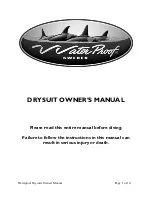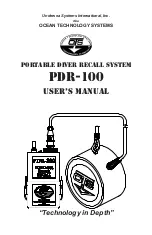
19
18
Note the meaning of below terms used in the manual:
THERAPY = HEALTH IMPROVEMENT and DIAGNOSTICS = PROGNOSIS OF HEALTH STATUS
Note the meaning of below terms used in the manual:
THERAPY = HEALTH IMPROVEMENT and DIAGNOSTICS = PROGNOSIS OF HEALTH STATUS
6.3 SETTING UP FOR BIORESONANCE MEASURES
Before you begin bioresonance testing, you need to set up the Professional device as follows:
Connect a short length of wire on the side of the device from the SEL connector to the PASSIVE
connector – you can use any of the two passive connectors, it does not matter as they are the
same (see Fig. 2).
Connect the hand electrode to a long wire from the remaining PASSIVE connector.
Press the PROBE button (see Fig. 4).
On the SELECTOR section of the device, press POWER and LIGHT
On the «THERAPY» panel of the device, where we see the THERAPY/DIAGNOSTICS switch, place
this on the DIAGNOSTICS section.
You are now ready for bioresonance testing.
Search Techniques and Electrical Parameter Measurement of Biological
Active Points (BAP)
In order to be successful in bioresonance testing using the Probe, it is important to identify the
correct point on the fingers. When one chooses an energetic point on the finger, in the middle of the
finger just below the nail bed (see Fig. 9), it does not matter how hard one press with the probe, the
conductivity indicator should show the same. This is the energetic point that interests us.
On a technical level, there are two points to bear in mind:
• We need to get the indicator correct by applying the correct pressure - this is known as
«opening» the point or energizing the point.
• Then we can ask the question and get the answer through the indicator.
It is known as bioresonance as we use a voltage input into
the energetic point (Voltage between the measure probe and
hand electrode is 1.25 V, current is not greater than 12.5 mkA).
If the energetic signature is the same as there is no
resonance, then there will not be an indicator drop. However, if
there is resonance then there will be a stress on the Autonomic
Nervous System and we will witness an indicator drop.
It is similar to the tuning fork phenomenon.
We use the mid-point of the fingers – not the acupoints as did Voll and Schimmel. We use a
pressure of about 100 – 150 grams.
The pressure will differ according to age, the condition of the skin, whether they have psoriasis,
etc. There are 10 fingers and we are free to choose whichever finger gives the best and most
reliable reading.
We need to use the lightest pressure that gives us the best reading. Using too much pressure
will result in «killing» the point and then we would need to calibrate with another point.
Always wet the probe point with a moistened cotton wool swab or use the swab directly on the
finger to moisten it. Try to keep the point or probe slightly moist throughout testing. It is best to use
a 0.1% saline solution to moisten the cotton wool ball.
If the indicator on the Voll setting (not VRT setting) gives us a reading above 20 unit then this
is acceptable. If is lower than 15 unit, then we need to find another finger. We usually use the first
three fingers, near the nail bed, in the middle of the finger. In these fingers and points there is
minimal movement of the skin so will not interfere with our readings.
At the point where you place the measure probe, there will be a little hollow like a little «hole».
This takes a little practice to master but persistence and patience is what is required to master this
crucially important technique.
Press the finger with the probe three times to energize it – on all three times it must show 20
unit or the same reading in order for it to be a reliable point. If there are differences between these
three readings then this is not a reliable point and either you have to find another finger, or check
the pressure of your measure probe – it should not be more than 100 – 150 g.
On the second time we can release the pressure to make certain that there is an indicator
drop. The third time we can again increase the pressure and we should find that the indicator drop
returns to the 20 unit level. If it does not then we would not use this point and find another finger.
The more one practices, the better the measurement will become as our muscles get trained
to use the same pressure consistently.
When you have found the point on the Voll testing mode and the reading is above 20 unit, then
you can press the second button on the measure probe while holding a firm pressure on the point
to enter the VRT mode, the indicator should automatically go to 80 (see Fig. 5, button 2).
Fig. 9
Summary of Contents for DeVita Professional
Page 27: ......











































